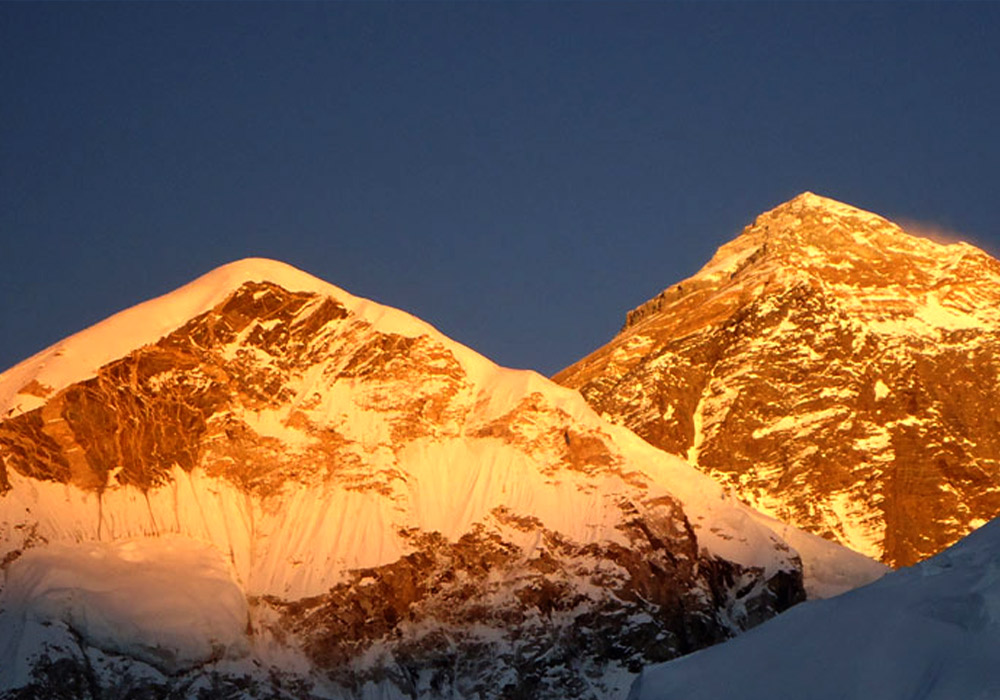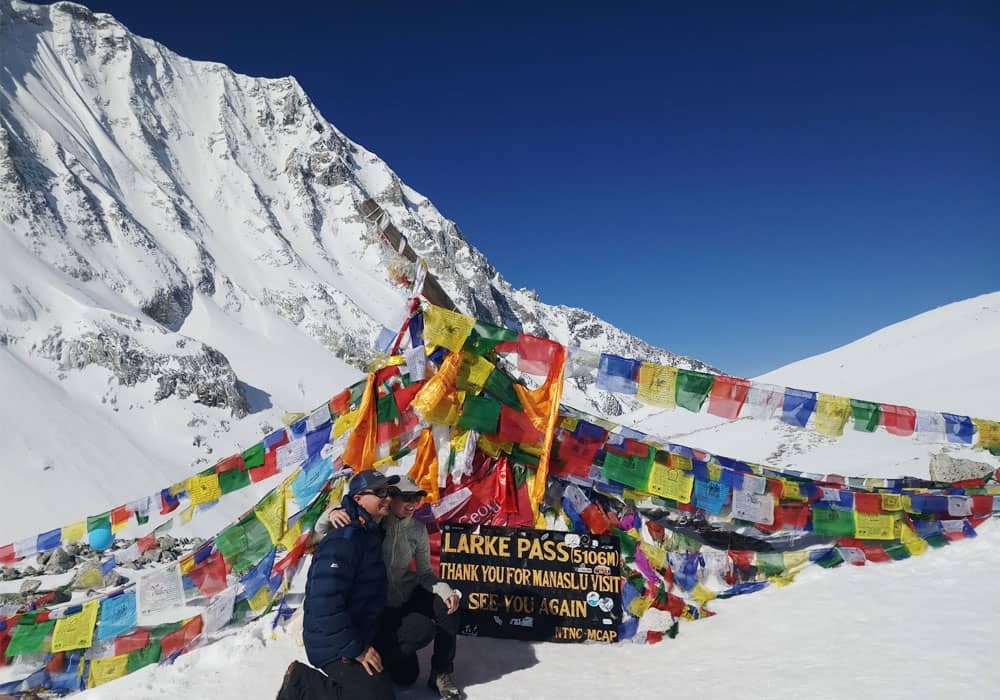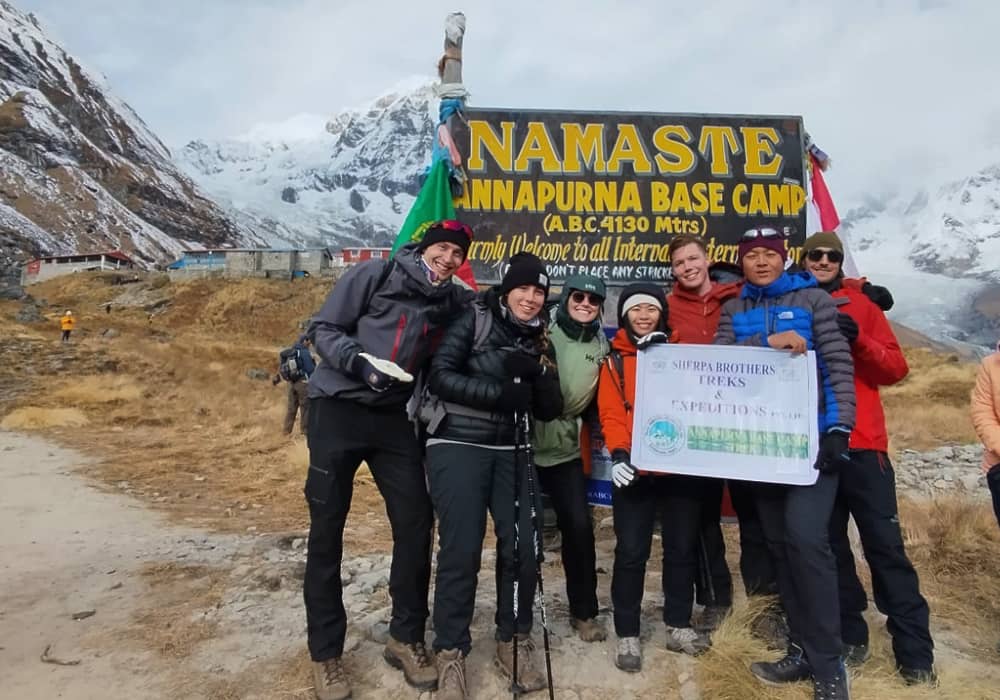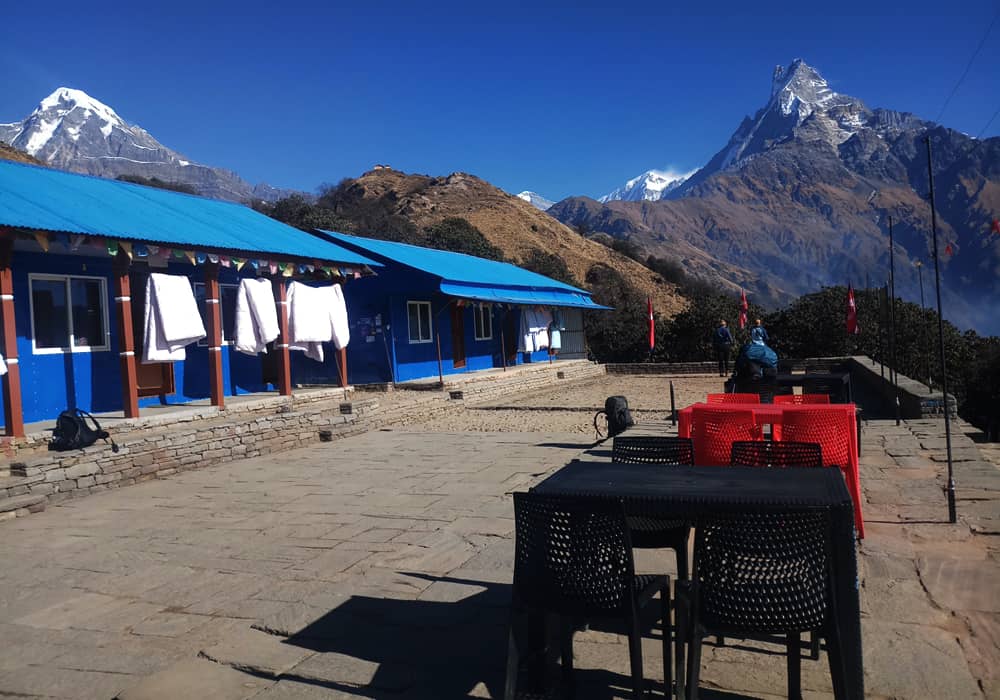Upper Mustang trekking is a unique privilege. Here, you’ll learn about the way of life of real mountain dwellers who, for many years, had little contact with the rest of Nepal and were able to preserve their rich cultural heritage. Given that Upper Mustang is geographically a part of the Tibetan plateau, trekking there is similar in many ways to trekking in Tibet. Within the borders of Nepal, the Mustang district was a separate kingdom until 1950. The king family of Mustang, still resides in and around the city known as Lo Manthang.
It takes 14 days to complete this moderately difficult trek. Maximum altitude is 3,730 meters, and daily walking is 6 -7 hours on average. This is one of the best peace trekking routes in Nepal because most of the ascent is gradual and most nights are spent at low to medium altitudes. The trip is also worth for planning medium altitude less strenuous trip attempting to make first time trekking and hiking experience in the Himalaya with a family vacation or a trip with friends. It is vital that participants with pre-existing medical problems or conditions make these known to Sherpa Brothers Trek at the time of booking
Accommodation and Food
In Kathmandu & Pokhara: 3 star deluxe hotel with bead and breakfast on twin sharing.
On trek: Tea house accommodation ( trekking guest house) and food on full board ( Breakfast, Lunch and dinner tea coffee). The tea houses along the trekking route provide basic but comfortable accommodations, with twin sharing rooms available. These tea houses also offer a variety of delicious home cooked meals to keep you energized throughout the day, including breakfast, lunch, and dinner. Additionally, you can enjoy hot drinks such as tea or coffee to warm up after a long day of trekking.
Travel Insurance
Sherpa Brothers Treks and Expedition Pvt/ Ltd. take every care to make our treks safe and enjoyable. All our routes are scouted to ensure the trails are safe and the facilities along route are of an acceptable standard. In addition, we have vast experience of trekking at altitude and are trained to deal with Acute Altitude Sickness. However, due to terrain, weather and altitude, risk is not always predictable in the Himalaya. To ensure you have a worry free time with us, personal travel insurance is essential to cover the cost of unforeseen accident, illness or rescue. The costs involved can be large and personally overwhelming in the unlikely event of accident or injury.
All Nepalese staff, guides and porters employed by Sherpa Brothers Treks Pvt. Ltd. are insured locally but we regret that we cannot offer insurance for our clients.
When is the best time to do Upper Mustang trek in general ?
While Nepal can be visited all year, the best times to go walking and trekking to Upper Mustang are in the spring, summer (late February – July) and autumn (late September-Mid December).
Autumn; The best time of year to do Upper Mustang trek is supposedly in the autumn. With dry weather and crisp, clear skies, the mountain views are at their best. Since the summer monsoon, the countryside has been lush and green.
Spring; As the weather warms up in late February and May wide variety of trekking options become available. The gorgeous magnolia and rhododendron will be in bloom, even though the skies may be cloudier than in the fall.
Tiji Festival Ceremonies in May
May is a busy month in Upper Mustang because of the well-known community celebration, Tiji Festival of Cropping Initiation and Farmers Well-Being. During the Tiji festival, the streets of Upper Mustang come alive with vibrant processions and traditional dances. This festival holds great significance for the local community as it marks the beginning of the cropping season and symbolizes prayers for a prosperous harvest. Conversely, legend holds that it is also considered a sign of God defeating a demon celebration. The date of Tiji festival hold as per Tibetan lunar calendar each year, If you want to trek in Mustang in month of spring time, you should book well in advance because of the popular festival can get crowded during this time and accommodation, flights fill up fast.
Winter; Generally, winter brings bright, dry days, though the evenings are bitterly cold at altitude and snow can block certain path. Winter can be an excellent time to do Upper Mustang trek because there are fewer tourists, even though Upper Mustang trek might also be feasible by jeep trip during this season.
Summer; While trekking in the Upper Mustang is feasible in summer months from June – July and in September being the rain-shadowed regions of Himalaya offer ideal summer trekking opportunities. The Upper Mustang region is known for its unique landscapes, ancient monasteries, and traditional Tibetan culture. Exploring this remote area during the summer months allows trekkers to witness the vibrant greenery and blooming wildflowers that adorn the valleys, creating a picturesque setting for their journey. Although trekking to other part of Nepal during the summer months of Mid June to August can be more challenging due to the monsoon rains. There are some places that we believe are inappropriate for trekking, like Everest Base Camp, Manasalu, ABC, Annapurna Circuit. Although the trails are suitable for trekking, there can be limited views of the mountains and disruptions to internal flight schedules.
What aircraft can I travel in, and how much weight is allowed ?
The aircraft that is being flown from Pokhara to Jomsom airport is a Twin Otter and Dornier with twin engine, and it can accommodate up to 18 passengers including crew members. Your passenger ticket to Jomsom has a maximum weight limit of 15 kg. Ten kilograms of checked baggage and five kilograms of hand luggage are permitted. If you have and need to weigh more than the amounts mentioned above, an additional $12 kg will be charged.
How many permits will I need for Upper Mustang Trek ?
If you’re planning to trek to the Upper Mustang region, you require the Upper Mustang area restricted permit / which is also called special trekking permit and Annapurna conservation area permit ACAP entrance Permit. These permits are mandatory to enter Upper Mustang Area conservation areas along the trekking route in order to protect trekkers’ data and for their safety. The permits also help fund conservation efforts and support local communities.
Required gears check list for Upper Mustang Trek.
Having the right gear ensures that you are prepared for adventure and all challenges or emergencies that may arise during your mountain adventures. From proper clothing and footwear to essential tools and safety equipment, your gear provides the necessary support and protection needed to navigate through rugged terrains and unpredictable weather conditions.
Below we present you a require complete packing list suitable for this trek.
Hiking gears for Upper Mustang Trek
Day bag 1 – A porter will carry your primary gear in duffel bag (up to 12kg per trekker). You’ll need to bring your own daypack. 30–35L is adequate.
Dry Bag 1 – This protects your bag and clothing from potential moisture, wet object and rain.
Walking pole 1 – ( if necessary) Trekking poles can decrease the impact on your joints by up to 20%. They are excellent for knees while going down. We recommend adjustable Black Diamond trekking poles.
Water bottle or camel bag 1 – Capacity to carry 3 litre of water. Options: 2 x 1.5 litre wide mouth nalgene bottles or 2 litre platypus + 1 litre water bottle.
Head light 1 – You will need a headlamp with a good light output for any late-night restroom trips, as well as importantly for dark light as an alternative power supply at lodge due do unconditional power cut off. Petzl make renowned and affordable headlamps.
Knife / Multi tools – 1
Cloth and body wear
Down jacket 1 – You’ll need this for the whole trip as well as in the evenings at lodge camp when you’re tired, you feel the cold a lot more.
Sleeping bag 1 – rated 0°F, -20°F.
Light or medium wight warm hiking trouser 2 – an option of convertible trousers.
For the colder parts of the trek you’ll need good winter hiking pants – just make sure they are breathable.
Warm liner 1 – For extra warmth in sleeping bag.
Warm sun hats 1 – lot of heat is lost through your head, so be sure to get a warm thermal hat as well as one that protects your neck from the harsh rays of the sun.
Fleece / jacket and pants 1 – Modern technical fleeces (such as Polartec) make excellent insulation layers.
Windproof jacket and Pants 1 – pants with full-length zips make getting them on and off quick and easy.
Long and half sleeve hiking shirt 3 – As per you body size lightweight, moisture wicking long and short sleeved shirts.
Buff for (neck and head) – 1
Walking boot 1 – We recommend light- to mid-weight waterproof boots with good ankle support. You don’t need to go full-mountaineering boot.
Gloves / mittens 2 – For the cold nights through the trek and for the larke pass day, we recommend heavyweight, insulated, preferably water resistant gloves.
Warm hiking socks (wool / synthetic) 3-4, pairs of outer socks and 2-3 pairs of liner socks. We also recommend bringing 1 x thick thermal socks for higher altitude such as Lomangthang.
Gaiter 1 – Help keep your trousers clean in dusty, wet and muddy trail conditions
Flip flap/ Sandal 1 – To wear around after a day’s trek we recommend bringing a pair of sandals
Sun protection, health hygiene and water
Sun cream 1 – SPF 40+ Sunscreen is very important as the sun’s rays are much stronger at altitude.
Sun glass 2 – (incase of one broke) choose high UV protection glasses of any brand as sun intensity after 3500 is very high.
Sun hat 1 – if possible go for a hat that is wide-brimmed for protection, and has a neck cover if you aren’t going to be wearing a neck gaiter.
Lip guard 1 – To keep your lip moisturized in dry air and the stronger sun ray
Tooth brush – 1
Face wash soap – 1
Sanitizer wipes – 2/2, if you won’t be showering at altitude, so anti-bacterial ‘wet wipes’ are a good way of maintaining personal hygiene in the mountain.
Towel – 1
Electrolyte/Sports drink powdered formula for adding to your water Water can get pretty boring, so it’s a good idea to bring along an electrolyte formula that’s flavored to your liking.
Snacks energy bars of your preference – plan for 2-4 per day Snacks such as energy bars, trail mix, and candy can help give you a quick energy boost while on the trail. Just avoid anything with caffeine in it.
Ear plugs – For light sleepers. Snoring travels in quiet high altitude lodges
Prescription medicine
Water purifier tablet / lightweight pen filter
Toilet paper – Bring two rolls of toilet paper, one to keep in your daypack for use on the trail, and one in your duffel for use at tea house camp. Taking the cardboard center out makes it easier to transport.
Menstrual product for her
Diamox (if using)
Blister plasters – different shapes and sizes
Antibiotic cream or ointment
Hairbrush/comb
Foot powder
Nail cutter
Personal belonging items
Passport
Cash Visa / credit card
Cell phone
Power bank backup and charger – The standard voltage of electricity in Nepal is 230 V and the frequency is 50 Hz. You can use your electric or electronic appliances in Nepal without a voltage converter.
Camera / Gopro
If hiking is something you’ve done before, you should know what is essential? How to pack and use gears? Layer clothes to stay warm and dry. It’s fairly easy for beginners if we concentrate on a few fundamental ideas here;
Important things to bear in mind before travelling from home and while on Upper Mustang Trek:
Bring essential trekking equipment on the plane with you, especially your walking boots, in case your luggage is delayed.
Pack a minimum of a jacket, rain pants, cameras, water, sunglasses, and a camera in your day pack. Since your main luggage won’t be accessible until the end of your trek for the day, pack any additional items you might need.
We will provide you duffel bag for your trip gear packing. Your main duffel bag will be carried by the porters. This pack can only hold a maximum weight of 12 kg per trekkers. Extra porters are needed for bags that are overweight or large.
To protect clothing from moisturizing objects, rain, and snow, place it in a dry bag.
Sherpa Brothers Treks key tips to you for staying warm in the mountains during Upper Mustang Trek-
The weather on the mountain is an unpredictable and subject to sudden changes. Low clouds, mist, and fog can make for a chilly and moist stroll even when it’s not raining. Even on a sunny day, the wind chill factor can make it feel very cold.
Never remain in wet clothes; as soon as you arrive at the campsite, change into dry ones.
You need outer layer to shield you from the cold wind and provide warmth in chilled weather. It should be both waterproof and breathable to resist liquid water passing through, but allow water vapour to pass through, facility to block out rain and snow while allowing vapour from sweat to evaporate.
In very cold weather, if you sweat and your base layer cannot keep the moisture out of your body, you run the risk of becoming chilled or, worse, hypothermic. To avoid the risk your inner or base layer shouldn’t be cotton, it needs to be wicking sweat, moisturize away from your body and breathable. Likewise, your mid-layer or next layer need to be warm and insulating helps sweat escape while retaining body heat.
You’ll need clothing for sleeping, relaxing in the evening, and trekking during the day. Since temperatures can vary due to changing altitude. Layers are therefore essential.
Clothes that are quick to dry, hand washable, breathable, and lightweight are ideal.
Not made of cotton! Cotton absorbs moisture rapidly since it doesn’t let it out.
It is not appropriate to hike in jeans, so don’t pack them.
Since cold weather shortens the life of batteries, bring extra sets.
Sherpa Brothers Treks Tips; How can you be practical and friendly with your Upper Mustang Trekking gears ?
Your daypack needs to be comfortable, with adjustable shoulder straps, and a hip belt. Choose one that fits properly, has room for a hydration bladder and water bottles, and is big enough to fit your rain gear, a few layers, and other daily necessities because you’ll be wearing it all day.
Not all daypacks come with a built-in rain cover; make sure to check and buy one separately.
Practice packing and unpacking your duffel bag and daypack; knowing where everything goes can be very helpful on those cold mornings when you struggle to get started.
Practice hiking with your boots, poles and your daypack. Experiment with putting on and taking off your daypack and adjusting it to fit different clothing layers combination.
Keep in mind what you will be doing before your trek, you’ll be able to leave excess luggage at the hotel in Kathmandu while you on trekking.
Don’t hesitate to ask us, get in touch with any questions you have. Our friendly and experienced team members will always be happy to help you.
Reservation cancellations policy
There will be no fees associated with cancellations made more than 45 days prior to departure.
A penalty of 30% of the total trip cost will apply for cancellations made between 30 and 44 days prior to departure.
60% of the total trip cost will be lost for cancellations made between 15 and 29 days prior to departure.
If a cancellation is made 14 days prior to departure, there will be no reimbursement.
Additional specifications
When making your reservation, please let us know about any special needs you may have so that we can make responsible efforts to accommodate your requests and special requirements, as long as the locations and resources allow.




 Trip Grade : Moderate
Trip Grade : Moderate Trip Durations : 14 Days From Kathmandu
Trip Durations : 14 Days From Kathmandu Highest Point : 3,770 m Lomanthang
Highest Point : 3,770 m Lomanthang  Best Season : Sep, Oct, Nov, Dec - Mar to August
Best Season : Sep, Oct, Nov, Dec - Mar to August Meal Plan : Breakfast in Kathamandu, Pokhara and Full board on Trek
Meal Plan : Breakfast in Kathamandu, Pokhara and Full board on Trek 

